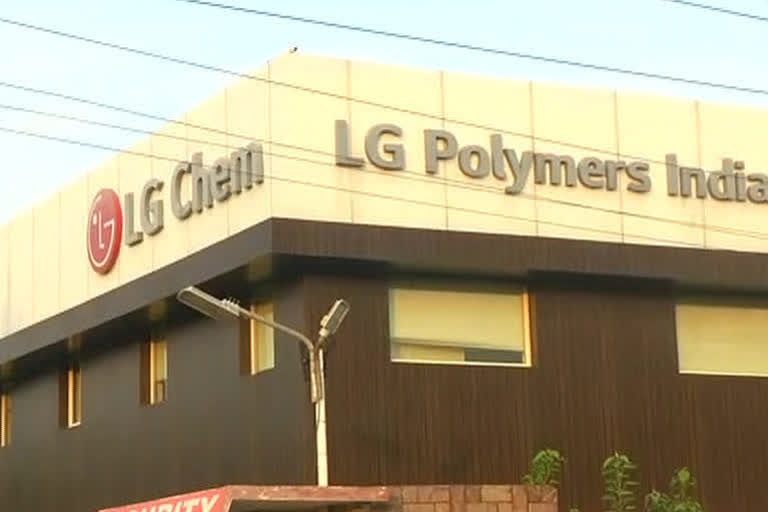New Delhi: The leak of toxic gas Styrene from the South Korean company LG Chem’s plant near Visakhapatnam on early Thursday morning points at the lapses committed by both the company and enforcement authorities, causing an avoidable disaster that eventually claimed at least 12 lives and affected more than 1,000 people.
Under the law, the Ministry of Environment and Forests is required to keep track of 1860 industrial units, also known as Major Accident Hazard (MAH) units, located in more than 300 districts across the country. LG Polymer's plant near Visakhapatnam also falls in the category of MAH units.
The environment ministry has Central Crisis Group (CCG) at the national level and State Crisis Groups (SCGs) and District Crisis Groups (DCGs) at the state and district levels to prevent and contain any chemical-industrial crisis.
Whether LG Chem did not follow the SOP
“In this case, glaring gaps can be seen at the unit level. It seems there was no Leak Detection and Radar (LDAR) system in place to detect the leaking equipment, else it could have been addressed timely,” said Amit Tuteja, Head of Disaster Risk Reduction of Knowledge Links, a Delhi based group that works with governments and other stakeholders for disaster reduction efforts.
He said that the LG Polymer’s unit should have exclusive onsite and offsite plans to deal with any such contingency.
An environmental activist and advocate Manmadha Rao also blames the company management and Andhra Pradesh State Pollution Control Board, other local authorities for the disaster.
“In my view, there is negligence on the part of management,” he said.
“It happened because there is a lacuna in Andhra Pradesh Pollution Control Board also. They should also be punished along with the management,” Manmadha Rao told ETV Bharat.
Read: Over 60% of leaked styrene vapour polymerized: Vizag DC
He said no government official inspected the company premise before permitting the company to restart the operation.
Early reports suggest that the leak occurred at around 2.30 am in the morning when some staff was allegedly trying to re-start the plant, which appears to be a violation of standard operating procedures (SOPs) for such industries.
“MAH units should also follow SOPs with regard to pre-startup hazards and risks based on assessments. Ideally, such plants are often re-started during the day time and not in the middle of the night,” Amit Tuteja told ETV Bharat.
Failure of government authorities
Experts and environment activists point out that in addition to the failure at the company level, relevant district and state authorities also failed in ensuring the compliance of the companies with the legal provisions.
Manmadha Rao told ETV Bharat that no inspector from the factories or industries departments visited the plant to inspect its condition before permitting the resumption of operation.
Chemical-Industrial Disaster reduction expert Amit Tuteja also blames the local administration for the lapse.
“At the local level the district administration is responsible,” Amit Tuteja told ETV Bharat.
He, however, also points out the lack of oversight on the part of the Ministry of Environment, Forests and Climate Change.
“Like NDMA functions through SDMAs and DDMAs, the MoEFCC is required to follow up with SCGs and DCGs and share updates with regard to chemical industrial disasters and related preparedness,” said Amit Tuteja who has previously worked with the National Disaster Management Authority as a chemical-industrial disaster management specialist.
He says that it is mandated as per EPPR Rules. Earlier the environment ministry used to do it but it is not doing it now,” he added.
Read: Vizag gas tragedy: Andhra HC issues notice to state, center
Styrene, which leaked from LG Chem’s plant in Andhra Pradesh, is listed at the entry number of 365 in the second part of the schedule 1 of Chemical Accidents (Emergency Planning, Preparedness and Response) Rules of 1996 (EPPR Rules).
The Government of India describes Styrene as a chemical having toxicity, which is capable of producing major accidents and hazards owing to its physical and chemical properties.
An official in the Ministry of Industries of Andhra Pradesh Government told ETV Bharat that no permission was given to the company for restarting the production.
“The company did not make any application and no permission was given to them to restart the production,” he told ETV Bharat.
“The company did notify the government for carrying out the maintenance activity which was permitted, passes for 45 people were issued with 15 persons in each shift,” he said.
He said the company started the maintenance activity on the basis of self-declaration which, according to him, was a norm in the industry. He, however, admitted that the maintenance activity was notified to the state government.
Laxity in following the offsite disaster plans
Amit Tuteja also says that there was no proper follow up for off-site plans.
These chemical safety drills help in checking the preparedness level and also in mobilizing the resources in and around such hazardous units.
“They help prepare the community to face any such scenario, how to cover, where to move, what to do at the local level,” he said.
He also cautioned that these mock drills should never be replaced with any virtual training.
“It seems that in Vizag the offsite plan could not be practised rigorously,” he observed.
ETV also sought the views of LG Chem. However, the company did not respond to an email sent by ETV Bharat seeking the details about the possible cause of the leak that resulted in the death of at least 12 people in India and affected more than 1,000 people.
The shocking incident prompted the National Green Tribunal and Andhra Pradesh High Court to take suo-moto notice of the incident. While NCT ordered the company to deposit Rs 50 crore as damages, the Andhra Pradesh High Court issued the notices to both the Centre and Andhra Pradesh government for conducting an inquiry into the incident.
Also Read: Vizag chemical plant gas leak incident needs to be fully investigated: UN chief



